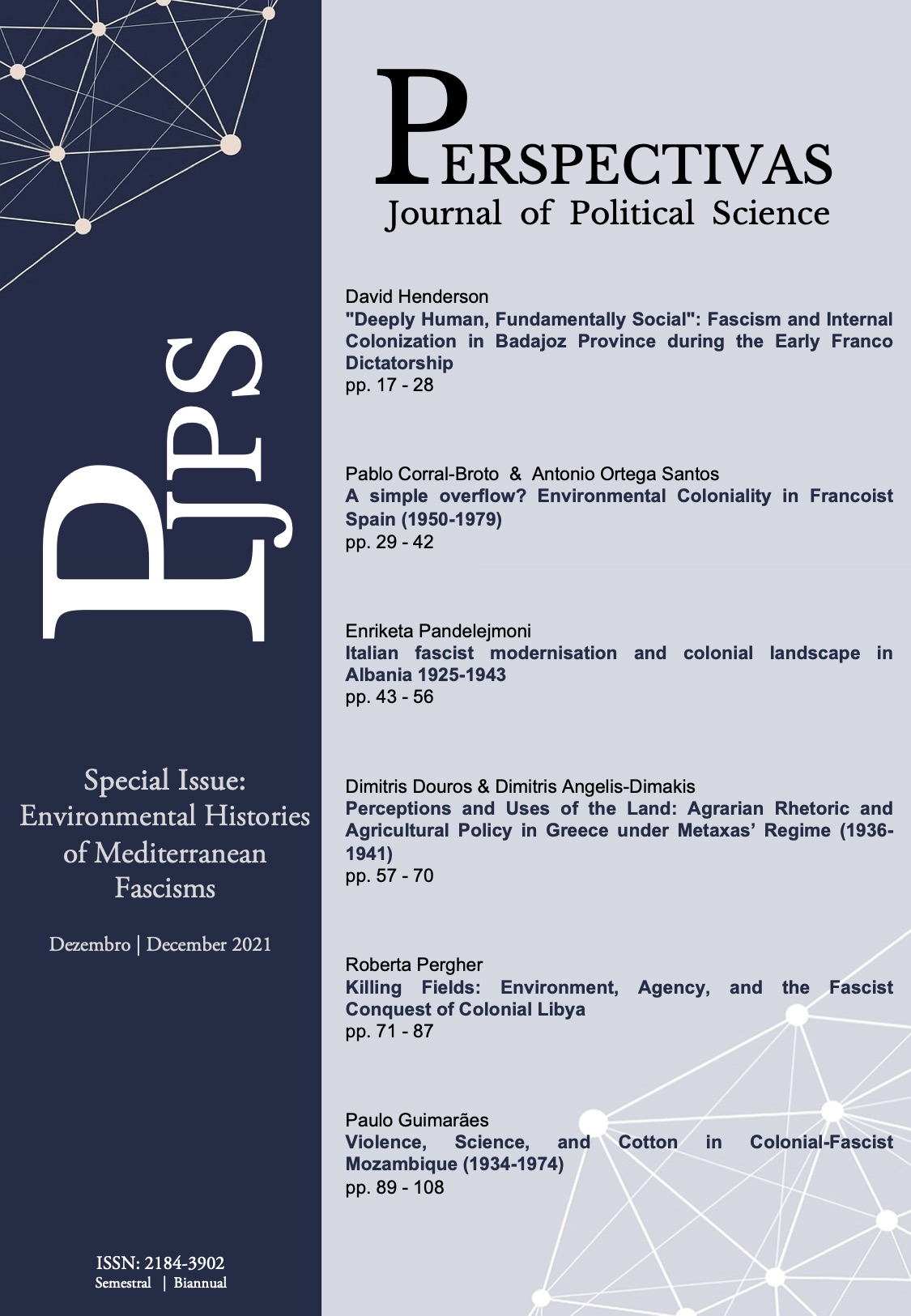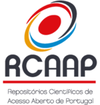Environmental Histories of Mediterranean Fascisms
Downloads
References
Amhida, Ali Abdullatif. 2021. Genocide in Libya: Shar, a Hidden Colonial History. Abingdon, Oxon ; New York, NY: Routledge.
Alcalde, Ángel. 2020. "The transnational Consensus: Fas- cism and Nazism in Current Research." Contemporary Eu- ropean History, 29: 243-252.
Armiero, Marco. 2016. "Environmental history between in- stitutionalization and revolution: A short commentary with two sites and one experiment." In Environmental human- ities. Voices from the Anthropocene. Edited by Serenella Iovino and Serpil Opperman, 45-59. London: Rowman & Littlefield Publishers.
Armiero, Marco (editor). 2014. Special Issue "Fascism and nature." Modern Italy 19(3).
Armiero, Marco, and Wilko Graf von Hardenberg. 2013. "Green Rhetoric in Blackshirts: Italian Fascism and the Environment." Environment and History, 19(3): 283-311.
Armiero, Marco, Biasillo Roberta, and Wilko Graf von Hardenberg. 2022 (Forthcoming). La natura del duce. Una storia ambientale del fascismo. Torino: Einaudi.
Arnd Bauerkämper, and Grzegorz Rossoliski-Liebe (edi- tors). 2017. Fascism without Borders: Transnational Con- nections and Cooperation between Movements and Regimes in Europe from 1918 to 1945. New York: Berghahn Books.
Biasillo,Roberta.2021."Socio-ecologicalcolonialtransfers: Trajectories of the Fascist agricultural enterprise in Libya (1922-43)." Modern Italy, 26(2): 181-198.
Biasillo, Roberta, and Claiton Marcio da Silva. 2021. "The very grounds underlying twentieth-century authoritarian regimes: building soil fertility in Italian Libya and the Brazilian Cerrado." Comparative Studies in Society and History, 63(2): 366-399.
Blackbourn,David.2006.TheConquestofNature.Water, Landscape and the Making of Modern Germany. New York: W. W. Norton & Co.
Bosworth, Richard. 1998. The Italian Dictatorship. Prob- lems and Perspectives in the Interpretation of Mussolini and Fascism. London: Arnold.
Bramwell, Anna. 1985. Blood and Soil: Richard Walther Darre’ and Hitler’s ’Green Party’. Abbotsbrook, Bourne End, Buckinghamshire: Kensal Press.
Brüggemeier, Franz-Josef, Cioc Mark, and Thomas Zeller (editors). 2005. How Green Were the Nazis? Nature, Envi- ronment and Nation in the Third Reich. Athens, OH: Ohio University Press.
Caprotti, Frederico, and Maria Kaïka. 2008. "Producing the ideal fascist landscape: nature, materiality and the cinematic representation of land reclamation in the Pontine Marshes." Social and Cultural Geography, 9(6): 613-634.
Dagnino,Jorge,MatthewFeldman,andPaulStocker(ed- itors). 2019. The ’New Man’ in Radical Right Ideology and Practice, 1919-45. London: Bloomsbury.
Dahl,Ottar.1999.Syndicalism,FascismandPost-Fascism in Italy, 1900-1950. Oslo: Solum Forlag.
De Grand, Alexander. 2000. Italian Fascism. Its Origins and Development. Lincoln, NA, and London: University of Nebraska Press (3rd edition).
del Arco Blanco, Miguel Ángel. 2021. "Famine in Spain During Franco’s Dictatorship, 1939-52." Journal of Contem- porary History, 56(1): 3-27.
Elazar,Dahlia.2001.TheMakingofFascism.Class,State, and Counter-Revolution, Italy 1919-1922. Westport, CT, and London: Praeger.
PERSPECTIVAS, JOURNAL OF POLITICAL SCIENCE, SPECIAL ISSUE 2021 15
Guido De Luigi, Edgar H. Meyer, Andrea Filippo Saba. 1995. "Nasce una coscienza ambientale? La Società italiana dell’alluminio e l’inquinamento della Val Lagarina (1928- 1938)." Società e Storia, 67: 75-109.
Baptista, Fernando Oliveira. 1993. A Política Agrária do Estado Novo. Porto: Edições Afrontament.
Gentile, Emilio. 2002. Fascismo. Storia e interpretazione. Bari-Roma: Laterza
Guimarães, Paulo E. 2020. "Environmental conflicts and men-nature representations in the building of the Por- tuguese European identity." In People, Nature and Environ- ments: Learning to Live Together. Edited by Ana C. Roque et al., 161-174. Cambridge: Scholars Publishing.
Gorostiza, Santiago. 2017. "Mobilising nature between democracy and Fascism. An environmental history of the Spanish Civil War and the legacies of the Francoist au- tarky". Ph.D. diss., University of Coimbra, Coimbra.
Gorostiza, Santiago. 2018. "’They Are the Pyrenees!’ For- tifying the Nation in Francoist Spain." Environmental His- tory, 23(4): 797-823.
Gorostiza, Santiago, and Miquel Ortega Cerdà. 2016. "’The unclaimed latifundium’: the configuration of the Spanish fishing sector under Francoist autarky, 1939-1951." Journal of Historical Geography, 52: 26-35.
Hamilton, Sarah R. 2017. "Environmental change and protest in Franco’s Spain, 1939-1975." Environmental His- tory, 22(2): 257-281.
Hardenberg, Wilko Graf von. 2021. A Monastery for the Ibex: Conservation, State, and Conflict on the Gran Par- adiso, 1919-1949. Pittsburgh, PA: University of Pittsburgh Press.
Hofmann, Reto, and Daniel Hedlinger. 2017. "Editorial - Axis empires: towards a global history of fascist imperial- ism." Journal of Global History, 12: 161-165.
Jacoby, Tim. 2016. "Global fascism: geography, timing, support, and strategy." Journal of Global History, 11: 451- 472.
Kallis, Aristotle. 2005. "Transnational Fascism: The Fas- cist New Order, Violence, and Creative Destruction." In How Green Were the Nazis? Nature, Environment and Na- tion in the Third Reich, edited by Franz-Josef Brüggemeier, Cioc Mark, and Thomas Zeller, 39-64. Athens, OH: Ohio University Press.
Law, Ricky W. 2019. Transnational Nazism: Ideology and Culture in German-Japanese Relations, 1919-1936. Cam- bridge: Cambridge University Press.
Lewis, Paul H. 2003. Latin Fascist Elites. The Mussolini, Franco and Salazar Regimes. Westport, CT: Praeger.
McNeill, John. 2010. "The State of the Field of Envi- ronmental History." Annual Review of Environment and Resources Vol. 35: 345-374. https://www.annualreviews. org/doi/10.1146/annurev-environ-040609-105431 (last ac- cess October 15, 2021).
Paxton, Robert O. 2004. The Anatomy of Fascism. Lon- don: Allen Lane.
Pollard, John. 1998. The Fascist Experience in Italy. Lon- don: Routledge.
Riley, Dylan. 2010. The Civic Foundations of Fascism in Europe: Italy, Spain and Romania, 1870-1945. Baltimore, MD: The Johns Hopkins University Press.
Roberts,DavidD.2002."Comment:Fascism,Single/Party Dictatorship, and the Search for a Comparative Frame- work." Contemporary European History, 11(3): 455-461.
Rogger, Hans and Eugen Weber (editors). 1996. The Eu- ropean Right. Berkeley: University of California Press.
Saraiva, Tiago. 2016. "Fascist modernist landscapes: Wheat, dams, forests, and the making of the Portuguese New State." Environmental History, 21(1): 54-75.
Saraiva, Tiago. 2017. Fascist Pigs: Technoscientific Or- ganisms and the History of Fascism. Cambridge, MA: MIT Press.
Tiago, Saraiva and M. Norton Wise. 2010. "Au- tarky/Autarchy: Genetics, Food Production, and the Build- ing of Fascism." Historical Studies in the Natural Sciences, 40(4): 419-428.
Sollai, Michele. 2021. "Microcosms of Colonial Develop- ment. Italian and Ethiopian Farmers at the Crossroads of Fascist Empire Building (1937-1941)." Contemporanea, 24(1): 79-101.
Staudenmaier, Peter. 2004. "Fascism". In Encyclopaedia of World Environmental History, edited by Shepard Krech III, John R. McNeill, and Carolyn Merchant, v.1, 517-521. London-New York: Routledge.
Swyngedouw,Erik.2015.LiquidPower.ContestedHydro- Modernities in Twentieth-Century Spain. Cambridge, MA.
Uekoetter, Frank. 2006. The Green and the Brown. A History of Conservation in Nazi Germany. New York and Cambridge: Cambridge University Press.
Valencia-García, Louie Dean. 2019. "Locating Dictator- ship in the Anthropocene: Historiographic Trends in the History of Science and Technology and the Study of Euro- pean Authoritarianism." Contemporary European History, 28(1): 120-130.
Downloads
Published
How to Cite
Issue
Section
License

This work is licensed under a Creative Commons Attribution-NonCommercial 4.0 International License.
Authors must be sure that they have permission to reproduce copyright material, prior to submitting their articles to this Journal.
Authors must secure permission if they have permission to reproduce figures, tables, or any extract from the text of another source. This applies to direct reproduction as well as to any derivative reproduction.
In assigning copyright, authors retain their right to use their own material elsewhere, provided that the Journal is acknowledged as the original place of publication, and the Editorial Team is notified in writing in advance.
Further information on copyright policy please contact info@perspectivasjournal.com








